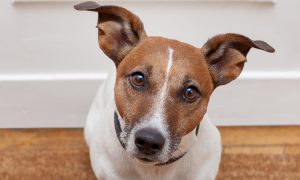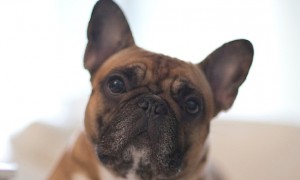The following is a guest post by Jennifer Warner Jacobsen, Adopt-a-Pet.com
Happily, house-training your new dog or puppy can take patience and time, but it is usually not complicated! We have lots of experience from house-training many foster dogs and puppies, and helping new adopters to easily and kindly train their new canine family member to take care of ‘business’ in the appropriate potty spot. We prefer the term “house-training” to “house-breaking” because you really are training your puppy or dog to go where you want – hopefully without having to break any bad habits! Here are the basic steps to house-training your dog or puppy:
SUPERVISE
Keep your dog under constant supervision while inside – if you must take your eyes away even for a second, confine your dog either in a crate (proper crate training is needed), or in a room with a hard-surfaced floor where accidents may be easily cleaned up, or outside in a secure area. With some dogs and in some homes its best to “tether” them to you, keeping them on a leash attached to you at all times. Close doors or block off carpeted rooms and rooms with rugs that can’t be taken up.
PICK A SPOT
It is easiest for a dog to learn to go in one specific spot, rather than just outside. Pick a “potty” spot, be it in your yard, a grassy area out front, or a corner of your patio. Most dogs prefer porous surfaces (dirt/grass/gravel/carpet/newspaper) if you have a bit of what the dog has gone on before, you can place it where you want the dog to go.
MAKE A ROUTINE
In the beginning, the more often you go to the potty spot, the better you chances of success! Put your dog and yourself on a firm daily schedule of sleeping, feeding and play/exercise, and your dog will start to go to the bathroom on a schedule. And you can make sure he’s at the right spot when the time comes! A typical schedule would include going to the potty spot first thing when you wake up, after breakfast, then at set intervals throughout the day. Two hours apart is great. Longer times will work, it will just take longer for your dog to learn to physically be able to hold it for longer periods.
Take your dog to his potty spot at the times you’ve set and wait (on a leash is often best). Allow the dog to circle and sniff, but don’t encourage him to play…this is serious business time! Be patient and wait for at least five minutes. If he starts to relieve himself, praise quietly until he is finished, then praise him very enthusiastically and reward him with a game or food treat. If he doesn’t go, it’s back to supervision until the next set time. Continue with the routine, and once he’s going when you take him out, gradually increase the time between visits to the potty spot. When you’re down to three times a day and no more accidents inside (anywhere from two to six weeks), you’ve house-trained your dog.
LEARN THE COMMAND
A phrase like “Get Busy” or “Go Potty” (or anything else you prefer) can really help your dog to understand when and where to go the bathroom. Use it just like you use any verbal command – like “Sit,” you say it before you want your dog to do it, and then if he does, give him lots of praise and treats. It won’t work to say it too many times in a row (two or three is enough), and should be said in a happy tone of voice, never as a punishment. Also, if you catch your dog in the act of “getting busy” in the correct spot, you can say “Get busy!! Good dog! Get busy! Good good!!” so they associate that phrase with what they are doing.
REWARD
If you see your dog about to go, or in the middle of relieving himself indoors, you can say ‘NO’ firmly, but do not raise your voice or yell. Then, immediately take him to your chosen place outside and reward him – praise, treats or play, which ever he most enjoys. Although he has done nothing to be praised for, it is essential that he associate going to that place with reward. If you have caught him in time he will still need to go. If he does go, lots of praise and rewards!
PUNISHMENT?
The worst thing you can do is punish your dog for ‘accidents’ that you discover after the fact. Dogs cannot make a connection with punishment for something they did in the past. Some owners will say, “Oh, but he knows he has done wrong because if I show him the mess he looks guilty.” The dog has simply learned that if humans are present and there is a mess on the floor, he is likely to be told off or punished, and yes he will cringe or cower down if you yell. He has not learned not to make the association – and not to make the mess in the first place.
Also… Yelling, making a loud noise with pennies in a can, swatting your dog with a newspaper, pushing your dog’s nose in his mess… aside from being inhumane, they often have the effect of making the dog afraid of you… or afraid of going in front of you. Then, housebreaking will take even longer, or may never happen. This is usually what has happened to dogs that go in the house only when left alone, or in a back room when you aren’t watching. Positive reinforcement is the fastest, easiest way to train. Punishment is the slowest and least-pleasant way to get a dog to do what you want, and often doesn’t work at all, especially for housebreaking!
CLEAN
When or if your pooch has an accident inside your home, thoroughly clean by using biological washing powder solution or a specially formulated enzyme product to remove all traces of the smell. If possible, keep your dog away from these areas until the training is complete. If they keep going on the same spot, put a tarp-covered chair or other pee-proof object in front of or on top of that spot – or lock them out of that room until they are solidly house-trained.
These steps do work quickly for most dogs. However, some dogs or puppies, like those from pet stores and puppymills (where they are forced to go to the bathroom in the same tiny space where they sleep and eat) can be more of a challenge. If your dog is more than 8 months old, and after a month of following these steps you are still having accidents, please consult a professional trainer for assistance. Other reasons why your dog has accidents in the house may include: stress and tension in the household, anxiety (for example, about being left alone or changes in routine), illness and submissive urination. Before beginning any training program, a clean bill of health from your dog’s veterinarian is advised.
Sometimes it feels like it’s taking ‘forever’ and some dogs will make progress and then take a few steps back, but this positive-reinforcement housebreaking method has worked time and time again for many dogs around the world, and it can work for yours, too!







I love this homes for dogs project! It will compliment my new campaign I am working on as a Pet Friendly real estate agent. Very excited to generate buzz and will embrace this great cause. Thank you and will look to customize the video.
We are so thrilled to hear that!